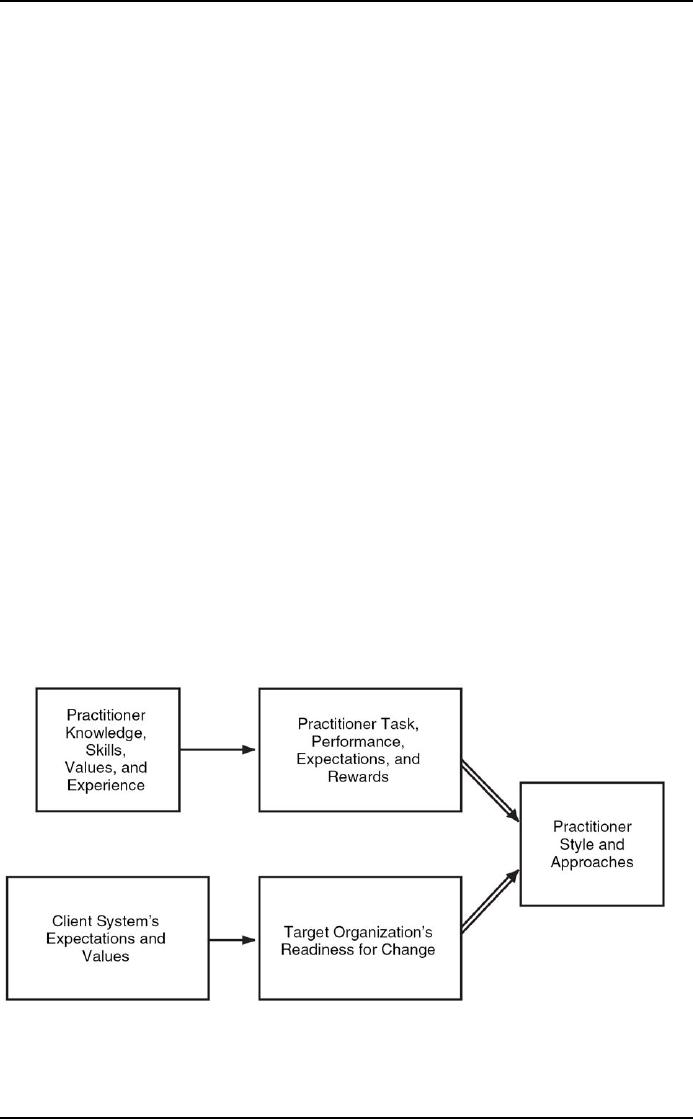 |

Organization
Development MGMT
628
VU
Lesson
10
The
Organization Development
Practitioner:
A
closer look at OD practitioners can
provide a more personal
perspective on the field and
can help us
understand
the essential character of OD as a
helping profession, involving
personal relationships between
practitioners
and organization members.
Much
of the literature about OD practitioners views them as
internal or external consultants
providing
professional
services--diagnosing problems, developing solutions,
and helping to implement them.
More
recent
perspectives expand the practice
scope to include professionals in related
disciplines, such as
industrial
psychology and organization theory, as
well as line managers who
have learned how to carry
out
OD
to change and develop their
departments.
A
great deal of opinion and
some research studies have
focused on the necessary skills
and knowledge of
an
effective OD practitioner. Studies of the
profession provide a comprehensive
list of basic skills
and
knowledge
that all effective OD practitioners must
possess.
Most
of the relevant literature focuses on people
specializing in OD as a profession and
addresses their
roles
and careers. The OD role
can be described in relation to the
position of practitioners: internal to
the
organization,
external to it, or in a team comprising
both internal and external
consultants. The OD
role
also
can be examined in terms of
its marginality in organizations, of the
emotional demands made on
the
practitioner,
and of where it fits along a
continuum from client-centered to
consultant-centered
functioning.
Finally, organization development is an emerging
profession providing alternative
opportunities
for gaining competence and developing a
career. The stressful nature
of helping professions,
however,
suggests that OD practitioners must
cope with the possibility of
professional burnout.
As
in other helping professions,
such as medicine and law,
values and ethics play an
important role in
guiding
OD practice and in minimizing the
chances that clients will be
neglected or abused.
Who
is the Organization Development
Practitioner?
The
term organization development practitioner refers to
at least three sets of
people. The most
obvious
group
of OD practitioners are those people
specializing in OD as a profession. They
may be internal or
external
consultants who offer
professional services to organization
clients, including top
managers,
functional
department heads, and staff groups. OD
professionals traditionally have
shared a common set of
humanistic
values promoting open communications,
employee involvement, and
personal growth and
development.
They tend to have common
training, skills, and
experience in the social processes
of
organizations
(for example, group
dynamics, decision making,
and communications). In recent
years, OD
professionals
have expanded those
traditional values and skill
sets to include more concern
for
organizational
effectiveness, competitiveness, and
bottom-line results, and
greater attention to the
technical,
structural,
and strategic parts of
organizations. That expansion, mainly in
response to the highly
competitive
demands facing modern organizations, has
resulted in a more diverse
set of OD professionals
geared
to helping organizations cope
with those pressures.
Second:
the term OD
practitioner applies to people
specializing in fields related to OD,
such as reward
systems,
organization design, total quality,
information technology, and business
strategy. These
content-
oriented
fields increasingly are becoming
integrated with OD's process
orientation, particularly as OD
projects
have become more
comprehensive, involving multiple
features and varying parts of
organizations.
For
example is the result of marrying OD with
business strategy. A growing number of
professionals in
these
related fields are gaining experience
and competence in OD, mainly
through working with
OD
professionals
on large-scale projects and
through attending OD training sessions.
For example, most of
the
large
accounting firms have diversified
into management consulting and
change management. In
most
cases,
professionals in these related fields do
not subscribe fully to
traditional OD values, nor do they
have
extensive
OD training and experience.
Rather, they have formal
training and experience in
their respective
specialties,
such as industrial relations,
management consulting, information
systems, health care, and
work
design.
They are OD practitioners in the sense
that they apply their special
competence within an
OD-like
process,
typically by engaging OD professionals
and managers to design and
implement change programs.
They
also practice OD when they apply their OD
competence to their own
specialties, thus spreading
an
OD
perspective into such areas
as compensation practices, work
design, labor relations, and
planning and
strategy.
Third:
the term OD
practitioner applies to the increasing
number of managers and administrators
who
have
gained competence in OD and
who apply it to their own
work areas. Studies and
recent articles argue
that
OD applied by managers rather than OD
professionals is growing rapidly.
They suggest that the
faster
pace
of change affecting organizations today is
highlighting the centrality of the manager in
managing
change.
Consequently, OD must become a
general management skill.
Along those lines, Kanter
studied a
growing
number of firms, such as General Electric, Hewlett-Packard,
and 3M, where managers
and

Organization
Development MGMT
628
VU
employees
have become "change masters.
They have gained the expertise to
introduce change and
inno-
vation
into the organization.
Managers
tend to gain competence in OD
through interacting with OD professionals
in actual change
programs.
This on-the-job training
frequently is supplemented with
more formal OD training,
such as the
variety
of workshops offered by the National
Training Laboratories, the Center for
Creative Leadership,
the
Gestalt Institute, UCLA's Extension
Service, University Associates,
and others. Line
managers
increasingly
are attending such external programs.
Moreover, a growing number of
organizations, including
Texas
Instruments, Motorola, and General Electric,
have instituted in-house
training programs for
managers
to learn how to develop and
change their work units. As
managers gain OD competence,
they
become
its most basic
practitioners.
In
practice, the distinctions among the
three sets of OD practitioners are
blurring. A growing number of
managers
have transferred, either temporarily or
permanently, into the OD profession. For
example,
companies
such as Procter & Gamble have trained
and rotated managers into
full-time OD roles so
that
they
can gain skills and
experience needed for higher-level
management positions. Also, it is
increasingly
common
to find managers using their
experience in OD to become external
consultants. More OD
practitioners
are gaining professional competence in
related specialties, such as
business process
reengineering,
reward systems, and organization
design. Conversely, many
specialists in those related
areas
are
achieving professional competence in
OD. Cross-training and
integration are producing a
more
comprehensive
and complex kind of OD practitioner,
one with a greater diversity of
values, skills, and
experience
than a traditional
practitioner.
External
and Internal Practitioners:
In
every large-scale planned change
program, some person or
group is usually designated to
lead the
change;
sometimes it is the OD practitioner. The
practitioner then, is the change leader,
the person leading
or
guiding the process of change in an
organization. Internal practitioners are
already members of the
organization.
They may be either managers practicing OD
with their work groups or OD
specialists that
may
be from the human resources or
organization development department. External practitioners
are
brought
in from outside the organization as OD
specialists and are often
referred to as consultants. Both
the
use of external and internal
practitioners have advantages and
disadvantages.
The
OD practitioners who are specialists,
whether from within or outside of the
organization are
professionals
who have specialized and
trained in OD and related areas,
such as the social
sciences,
interpersonal
communications, decision making,
and organization behavior. These
specialists, often
referred
to as OD consultants, have a more
formal and involved process
when they enter the client
system
than
managers who are doing OD
with their work group.
Although much of the chapter is
directed at OD
practitioners
who are specialists, the
concepts also apply to OD practitioners
who are managers and
team
leaders
implementing OD.
The
External Practitioner:
The
external
practitioner is
someone not previously associated
with the client system. Coming from
the
outside,
the external practitioner sees things
from a different viewpoint
and from a position of
objectivity.
Because
external practitioners are invited into
the organization, they have increased
leverage (the degree of
influence
and status within the client
system) and greater freedom of
operation than internal
practitioners.
Research
evidence suggests that top
managers view external practitioners as having a
more positive role in
large-scale
change programs than
internal practitioners.
Since
external practitioners are not a part of
the organization, they are less in awe of
the power wielded by
various
organization members. Unlike internal
practitioners, they do not depend upon
the organization for
raises,
approval, or promotions. Because they
usually have a very broad career
base and other clients to
fall
back
on, they tend to have a more independent
attitude about risk-taking and
confrontations with the
client
system.
At McKinsey & Co., a leading
management consulting firm, consultants
are direct, outspoken, and
challenge
the client's opinions. Once
"The Firm" (as McKinsey is
called) is hired, a four- to
six-person
"engagement
team" is assembled, with an experienced
consultant to coordinate the effort. Bear in
mind,
though,
that McKinsey's
management consulting work is not
necessarily organization development.
The
disadvantages of external practitioners result
from the same factors as the
advantage. Outsiders
are
generally
unfamiliar with the organization system
and may not have
sufficient knowledge of its
technology,
such
as aerospace or chemistry. They
are unfamiliar with the culture,
communication networks, and formal
or
informal power systems. In some
situations, practitioners may have
difficulty gathering pertinent
information
simply because they are outsiders.
Our Changing World
illustrates problems that
outside
management
consulting firms face in Germany.

Organization
Development MGMT
628
VU
The
Internal Practitioner:
The
internal
practitioner is
already a member of the organization: a
top executive, an organization
member
who initiates change in his or
her work group, or a member of the
human resources or
organization
development department. Many large
organizations have established offices
with the specific
responsibility
of helping the organization implement change
programs. In the past few years, a
growing
number
of major organizations (including Disney,
IBM, General Electric, General Motors,
Honeywell,
Union
Carbide, and the US. Army
and Navy) have created
internal OD practitioner groups.
These internal
practitioners
often operate out of the
human resources area and
may report directly to the
president of the
organization.
Internal
practitioners have certain advantages
inherent in their relationship with the
organization. They are
familiar
with the organization's culture and
norms and probably accept
and behave in accordance
with the
norms.
This means that they need
not waste time becoming
familiar with the system and
winning
acceptance.
Internal practitioners know the power
structure, which are the
strategic people, and how
to
apply
leverage. They are already
known to the employees, and
have a personal interest in
seeing the
organization
succeed. Unfortunately, it is by no means
easy for internal practitioners to
acquire all the
skills
they
will need. The proof is in
the problems encountered by new, not
quite ready internal practitioners
or
managers
who take on projects before they
are fully comfortable with
their practitioner roles in
the
organization,
and before they understand and
have developed critical skills.
The
position of an internal practitioner
also has disadvantages. One of
these may be a lack of
the
specialized
skills needed for organization
development. The lack of OD skills
has become a less
significant
factor
now that more universities
have OD classes and programs
and their graduates have
entered the
workforce.
Another disadvantage relates to
lack of objectivity. Internal
practitioners may be more likely
to
accept
the organizational system as a given and
accommodate their change
tactics to the needs of
management.
Being known to the workforce
has advantages, but it can
also work against the
internal
practitioner.
Other employees may not
understand the practitioner's role and
will certainly be influenced by
his
or her previous work and relationships in
the organization, particularly if the work and
relationships
have
in anyway been questionable.
Finally, the internal practitioner
may not have the necessary
power and
authority;
internal practitioners are sometimes in a
remote staff position and
report to a mid-level
manager.
The
OD practitioner must break
through the barriers of bureaucracy
and organizational politics to
develop
innovation,
creativity, teamwork, and trust within
the organization.
The
External-Internal Practitioner
Team:
The
implementation of a large-scale change
program is almost impossible without the
involvement of all
levels
and elements of the organization. One
approach to creating a climate of
change uses a team
formed
of
an external practitioner working directly
with an internal practitioner to
initiate and facilitate
change
programs
(known as the external-internal
practitioner team).This is
probably the most effective
approach.
OD researcher John Lewis, for
example, found that
successful external OD practitioners
assisted
in
the development of their internal
counterparts. The partners
bring complementary resources to the
team;
each
has advantages and strengths
that offset the disadvantages
and weaknesses of the other.
The external
practitioner
brings expertise, objectivity,
and new insights to organization
problems. The
internal
practitioner,
on the other hand, brings
detailed knowledge of organization issues
and norms, a
long-rime
acquaintance
with members, and an
awareness of system strengths
and weaknesses. For change
programs
in
large organizations, the team
will likely consist of more
than two practitioners.
The
collaborative relationship between internal
and external practitioners provides an integration
of
abilities,
skills, and resources. The
relationship serves as a model for the
rest of the organization--a model
that
members can observe and see
in operation, one that
embodies such qualities as trust,
respect, honesty,
confrontation,
and collaboration. The team
approach makes it possible to
divide the change
program's
workload
and share in the diagnosis,
planning, and strategy. The
external-internal practitioner team
less
likely
to accept watered-down or compromised
change programs because each
team member provides
support
to the other. As an example, during the
U.S. Navy's Command
Development (OD) Program,
the
internal
change agents recommended
that training seminars be
conducted away from the
Navy
environment
(i.e., at a resort) and the participants
dress in civilian clothing to
lessen authority it
issues.
Higher
authority, however, ordered the seminars to he held on
naval bases and in
uniform--ground rules
that
the internal practitioners reluctantly accepted. In
this situation an external practitioner with
greater
leverage
might have provided enough support
and influence to gain approval to the
desired program.
Another
reason for using an external-internal
practitioner team is to achieve
greater continuity over
the
entire
OD program. Because external practitioners
are involved in other
outside activities, they generally
are
available
to the organization only a few days a
month, with two- or
three-week intervals between visits.
The
internal
practitioner, on the other hand, provides
a continuing point of contact
for organization members
whenever
problems or questions arise.
Because many OD programs are
long-term efforts, often
lasting

Organization
Development MGMT
628
VU
three
to five Years, the external-internal
combination may provide the
stimulation and motivation
needed
to
keep the change program moving
during periods of resistance.
The team effort is probably
the most
effective
approach because it combines the
advantages of both external and
internal practitioners while
minimizing
the disadvantages.
Practitioner
Style Model:
There
is often a gap between the practitioner's
and the client's understandings
about OD and change.
The
practitioner
needs to assess the degree of this
gap, because a relationship is possible
only if the practitioner
can
be flexible enough to understand
where the client is and help
the client to learn about the OD
change
process.
In this sense, the practitioner must
have clarity about the purpose of OD in
the organization. The
practitioner
brings certain knowledge, skills,
values, and experience to the situation.
In turn, the client
system
has its own values
and a set of expectations
for the practitioner. The
target organization within the
client
system has its own
subculture and level of readiness
for change.
The
practitioner's task and the scope,
difficulty, and complexity of the
changes to be implemented affect
the
relationship as well. Finally, the target
organization's readiness, for change,
level of resistance, and
culture
also influence the practitioner's style
and the change approaches
that may be successful in a
given
situation.
The OD practitioner needs to
involve organization members at all
levels and convince them to
"buy
in" on the change program--in effect, to
get involved in soling the
problems.
Developing
a Trust Relationship:
The
development of openness and trust between
practitioner and client is an essential
aspect of the OD
program.
It is important because trust is
necessary for cooperation and
communication. When there is no
trust,
people will tend to be dishonest,
evasive, and not authentic
with one another, and communication
is
often
inaccurate, distorted, or incomplete. There are
several basic responses that
the practitioner may use
in
the
communication process aimed at developing
a trust relationship:
�
Questions
--"How do
you see the organization?"
�
Applied
expertise (advising) --"One
possible intervention is team
building."
�
Reflection
"It
sounds like you would
like to see a participative form of
leadership."
�
Interpretation
--"From
your description, inter-team conflict could be the
problem."
�
Self-disclosure
--"I've
felt discouraged myself when my
ideas were rejected."
�
Silence
--Say
nothing, let the client sort
out his or her
thoughts.
Figure:
09 Practitioner Style Model
How
these basic responses are
used is important in developing the
practitioner-client relationship, in
general
the more balanced the practitioner's use
of these responses and the
more open the range of
responses,
the higher level of trust. For example,
some practitioners rely almost
exclusively on questions
without
sharing their own ideas
and feelings. This tends to
create a one-way flow of
information. Other

Organization
Development MGMT
628
VU
practitioners
rely heavily on advising responses, which
may tend to develop a dependency
relationship. It is
important
for the practitioner to be aware of the
range of responses and to
use those that will
build an
open
and trusting relationship.
During
the first several contacts
with the client system, the
following types of questions
may be reflected
upon:
�
What
is the attitude of the client system
toward OD? Is there a real
underlying desire for
change?
Or
is the attitude superficial?
�
What
is the gut-level meaning of the client's
problem? How realistic is the
client's appraisal of
its
own
problems?
�
What
are the possibilities that an OD program
will alleviate the problem?
Can OD solve the
problem
or are other change programs
more appropriate?
�
What
is the practitioner's potential impact on the
system? Based on feedback
from the client, how
probable
is it that the practitioner can
bring about significant
change?
Once
these questions are
answered, the practitioner can
decide whether to continue the change
efforts or
to
discontinue and terminate the relationship. Most OD
practitioners recommend an open discussion
with
the
client on these issues at an early
stage.
Table of Contents:
- The Challenge for Organizations:The Growth and Relevance of OD
- OD: A Unique Change Strategy:OD consultants utilize a behavioral science base
- What an “ideal” effective, healthy organization would look like?:
- The Evolution of OD:Laboratory Training, Likert Scale, Scoring and analysis,
- The Evolution of OD:Participative Management, Quality of Work Life, Strategic Change
- The Organization Culture:Adjustment to Cultural Norms, Psychological Contracts
- The Nature of Planned Change:Lewin’s Change Model, Case Example: British Airways
- Action Research Model:Termination of the OD Effort, Phases not Steps
- General Model of Planned Change:Entering and Contracting, Magnitude of Change
- The Organization Development Practitioner:External and Internal Practitioners
- Creating a Climate for Change:The Stabilizer Style, The Analyzer Style
- OD Practitioner Skills and Activities:Consultant’s Abilities, Marginality
- Professional Values:Professional Ethics, Ethical Dilemmas, Technical Ineptness
- Entering and Contracting:Clarifying the Organizational Issue, Selecting an OD Practitioner
- Diagnosing Organizations:The Process, The Performance Gap, The Interview Data
- Organization as Open Systems:Equifinality, Diagnosing Organizational Systems
- Diagnosing Organizations:Outputs, Alignment, Analysis
- Diagnosing Groups and Jobs:Design Components, Outputs
- Diagnosing Groups and Jobs:Design Components, Fits
- Collecting and Analyzing Diagnostic information:Methods for Collecting Data, Observations
- Collecting and Analyzing Diagnostic information:Sampling, The Analysis of Data
- Designing Interventions:Readiness for Change, Techno-structural Interventions
- Leading and Managing Change:Motivating Change, The Life Cycle of Resistance to Change
- Leading and managing change:Describing the Core Ideology, Commitment Planning
- Evaluating and Institutionalizing Organization Development Interventions:Measurement
- Evaluating and Institutionalizing Organization Development Interventions:Research Design
- Evaluating and Institutionalizing Organization Development Interventions
- Interpersonal and Group Process Approaches:Group Process
- Interpersonal and Group Process Approaches:Leadership and Authority, Group Interventions
- Interpersonal and Group Process Approaches:Third-Party Interventions
- Interpersonal and Group Process Approaches:Team Building, Team Building Process
- Interpersonal and Group Process Approaches:Team Management Styles
- Organization Process Approaches:Application Stages, Microcosm Groups
- Restructuring Organizations:Structural Design, Process-Based Structures
- Restructuring Organizations:Downsizing, Application Stages, Reengineering
- Employee Involvement:Parallel Structures, Multiple-level committees
- Employee Involvement:Quality Circles, Total Quality Management
- Work Design:The Engineering Approach, Individual Differences, Vertical Loading
- Performance Management:Goal Setting, Management by Objectives, Criticism of MBO
- Developing and Assisting Members:Career Stages, Career Planning, Job Pathing
- Developing and Assisting Members:Culture and Values, Employee Assistance Programs
- Organization and Environment Relationships:Environmental Dimensions, Administrative Responses
- Organization Transformation:Sharing the Vision, Three kinds of Interventions
- The Behavioral Approach:The Deep Assumptions Approach
- Seven Practices of Successful Organizations:Training, Sharing Information